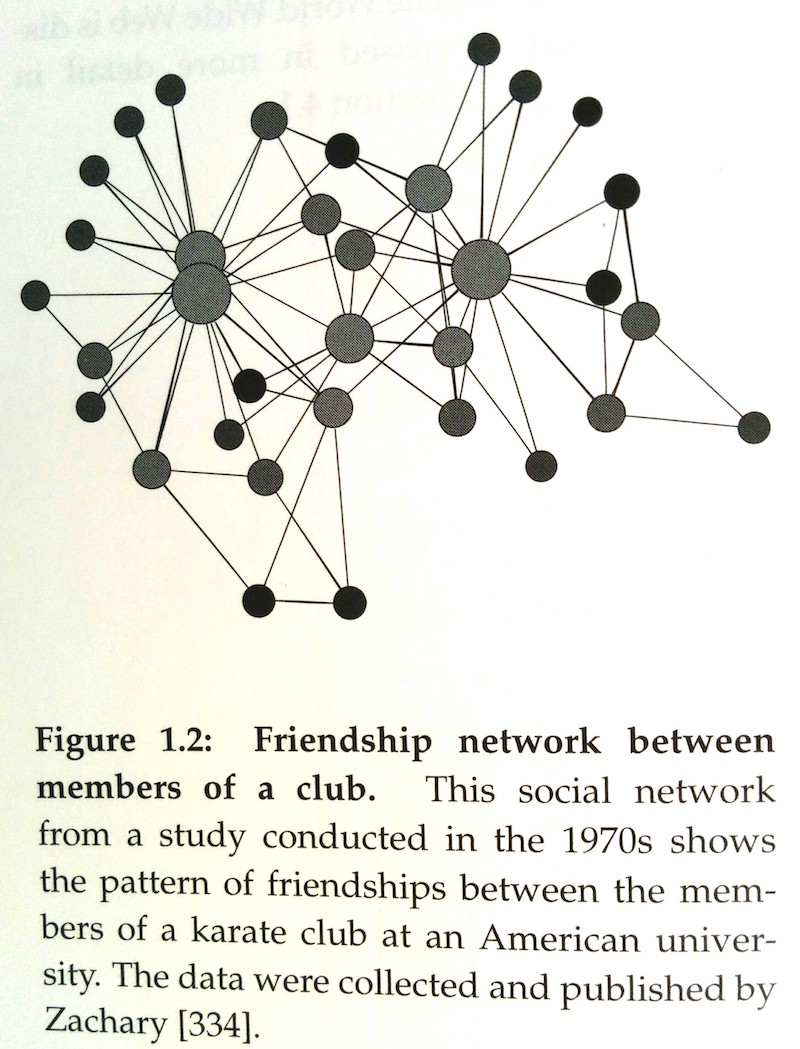A Social Network is a duet for two microtonally tuned electric guitars based on a sonification of the network of social connections in a karate club. Why karate? I'll get to that, but first the music:
You can also take a look at the score here.
Thanks so much to the efforts of Ramon Fermin and David Gonzales of Ignition Duo for the above recording. A Social Network was included as part of their CD Ablaze Amidst the Horns, which you should definitely check out.
Under a fairly tight deadline to write something for the duo, I circled back to an idea I'd had to sonify (translate into sound) a network. I had been playing with creating music from networks for some time (see Ramify), and, leafing through a book on networks that I have, I was attracted to the following image:

I had my muse.
The diagram represents the social connections (i.e. who is friends with whom) between members of a karate club. Eyeballing the diagram, it was clear that there were a couple of main karate-ers who were especially well connected; these are known as hubs. You know which ones I mean: if the diagram is an owl's face—which, I mean, it seriously looks like an owl—then these people are the eyes. Having noticed this, I decided to assign a pitch to each node in the network by making these hubs the fundamentals two different harmonic series (E and B♭), and making their associates the overtones. Club members who were on the fence, relatively equally connected to both hubs, were assigned high harmonics that switched back and forth between a tuning based on one harmonic series or the other (thereyby sonifying their indecision).
I then had the guitars use a special tuning of the strings that allowed them to easily play the harmonics of an E and B♭ overtone series, respectively. In this way, the two subgroups were split between the guitars, dramatizing the apparent division in the network.
All of that took care of the pitch material. The rhythmic process was much simpler, playing with gradual changes in density. Inputting the whole thing into my computer program, Ramify, I arrived at the following:
After a little tweaking, this became the music for A Social Network.
Shortly before the piece was performed, I was chatting with my sister-in-law (hi Clare!), and telling her about the project. She was getting her PhD in Public Health at the time, and networks come into play frequently in her work (such as in studying the spread of disease or the dissemination of health information). It turns out she had the exact same network book that I did (though I think she's done more than leaf through it), so she looked up the page with my chosen network. To my surprise she knew the network by name ("That's the karate club network!"). It turned out to be one of the most studied networks in the history of the field. This seemed like a hilarious coincidence, though now that I think about it, I'm not sure what else I should have expected from the introductory chapter of an introductory book about networks.
The true coincidence has to do with the reason this particular network is so well studied. It turns out that shortly after the data was collected, Hub A and Hub B had a falling out and the club was "chopped" into two rival karate clubs*. Thus, I had inadvertently constructed my piece in perfect counterpart to the real life situation the network portrayed!
It was a proud moment.
*In case you're curious, the reason this is so valuable to a network researcher is because they are often in the position of trying to identify sub-groups within a network, and this provided a perfect case study.